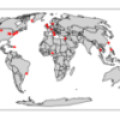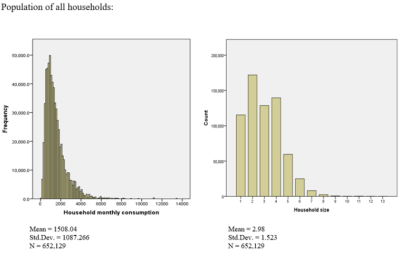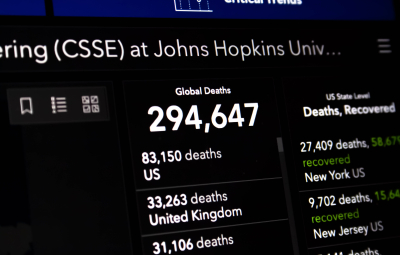“We don’t exactly have a track record of selling most of our work to the world, do we?” wrote Janine Illian in her 18 May 2021 post, Found in Translation. This blog is one way we, as a community, can share the value of statistical insights with the world, from making personal decisions to national policies. Just over a year ago, a suggestion within the ISI’s Committee on Public Voice led to the creation of a committee and then the start of this blog. The main purpose of the blog was for statisticians “to share our approach to reading the news, the questions we ask, and the conclusions we make (or don’t make).”
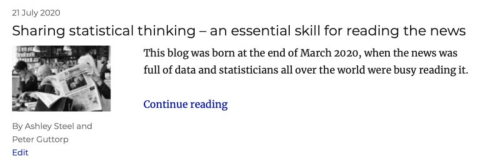
In the inaugural post on 21 July 2020, we conveyed our hope that the blog would “encourage curiosity and continued learning about statistical thinking.” Since then, we have had 47 posts, written by a variety of authors from around the world. Here is a map with dots at author locations:
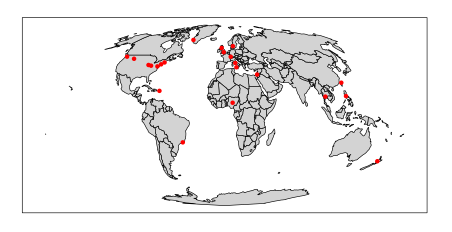
We think the blog has mostly functioned the way we intended, with a few exceptions which we discuss later in this post. Of course the COVID-19 pandemic, with its use and misuse of statistics and probability, has been a frequent topic. But, over half of the posts have been about something else, ranging from how statistics can bring joy to people (Gemma Van Halderen, 6 Oct. 2020) to where people are fleeing (Lelys Bravo de Guenni, 25 May 2021). We have covered elections in the USA and Greenland, mindfulness, peanut butter, stochastic terrorism, and space junk. As to COVID-19, we have pondered the statistical backbone of issues in vaccination hesitance, demography, risk, false positives, disclosure of data, and data comparability, among many others. We also discussed issues such as information beyond quantitative data, data privacy, education systems, and teamwork. The common thread is the reaction of a statistician (or a scientist with statistical background) to issues in their news feed.
Did anyone read the blog? To some extent. The most viewed post is John Bailer’s text on whether a positive COVID test means one has the disease, with nearly 6000 views. Most entries have at least 2000 views. The total page views per day peaked at almost 1000, but now hovers between 250 and 350.
We don’t know much about who is reading the blog. We hoped that people not typically interested in Statistics might find that they enjoyed the insights and become returning readers. Now we wonder whether readers without a strong statistical background did in fact find new reasons to value statistical thinking, or even leverage it in their personal or professional lives. We also imagined that teachers, of all sorts, might use the posts as educational resources. Of course, it has been a tough year for teachers, most of whom were faced with radical shifts in the way they delivered content and generated enthusiasm – and even in ordinary times, we would expect a delay as teachers discover the content and experiment with how to use it. Overall, we remain uncertain of the blog’s reach and impact.
What has worked well? Most statisticians we approached agreed to write a post and we found all the posts engaging and interesting. The diversity of topics widened our vision of Statistics and the many ways that statistical thinking can make the world a better place. Non-statistician friends have been interested and, although they don’t generally comment on the blog, they shared posts via social media and provided personal anecdotes about what they learned and how it helped them feel less anxious, make a better decision, or find a big of enlightened skepticism when reading the news. As authors of posts, we have met each other. We have connected across a shared, global passion for communicating and valuing Statistics during a year when connections were particularly valuable.
What has been disappointing? The decline in page views is one of the ways in which the blog has not worked the way we hoped. The other is the disappointing lack of comments (on average just over 1 per post, with several of the posts having no comments at all). Is there just no room in people’s routine for reading one more blog, for spending 10 more minutes on-line? Is the content too diverse, reaching some interested readers every week but not leading to a core group? Is it simply a matter of patience – waiting for the community to develop and increasing our visibility?
For the next year, we will expand the volunteer editorial committee to share the load and are actively looking for volunteers to help with finding and scheduling contributors, publicizing the blog, and designing and publishing posts. We will also reduce the frequency of posts to once every two weeks instead of every week. We hope that the ISI community will embrace the blog by engaging in discussions in the comments, sharing posts on social media, exploring how to use posts in both formal and informal educational settings, and volunteering to write posts.

